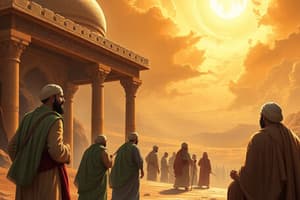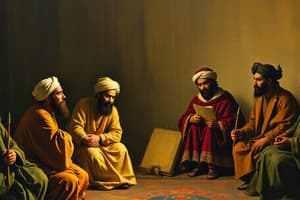Podcast
Questions and Answers
What was one of the roles of Arab scholars and administrators in the spread of Islam?
What was one of the roles of Arab scholars and administrators in the spread of Islam?
- They aided in cultural transformations. (correct)
- They enforced military laws.
- They focused solely on territorial expansion.
- They created conflict between tribes.
How did the establishment of Islamic institutions affect conversion?
How did the establishment of Islamic institutions affect conversion?
- They offered knowledge and religious guidance. (correct)
- They provided entertainment facilities.
- They hindered access to knowledge.
- They were primarily for trade purposes.
What characterized the process of conversion to Islam?
What characterized the process of conversion to Islam?
- It was typically quick and automatic.
- It was uniform across all tribes.
- It included varying degrees of religious adherence. (correct)
- It completely replaced all existing traditions.
What role did trade networks have in the spread of Islam?
What role did trade networks have in the spread of Islam?
What does the experience of conversion signify in various regions?
What does the experience of conversion signify in various regions?
How should narratives of mass conversion be viewed?
How should narratives of mass conversion be viewed?
What sometimes influenced the decision to convert to Islam?
What sometimes influenced the decision to convert to Islam?
What impact did intermarriage have on the spread of Islam?
What impact did intermarriage have on the spread of Islam?
What was one of the central teachings emphasized in Muhammad's message?
What was one of the central teachings emphasized in Muhammad's message?
What significant event occurred in 622 CE related to Muhammad and his followers?
What significant event occurred in 622 CE related to Muhammad and his followers?
How did the early Islamic community primarily spread its influence?
How did the early Islamic community primarily spread its influence?
What aspect of Islam was particularly appealing compared to the pre-Islamic practices?
What aspect of Islam was particularly appealing compared to the pre-Islamic practices?
What social change did Islam promote that attracted many converts?
What social change did Islam promote that attracted many converts?
What influenced the gradual process of conversion to Islam among Arabs?
What influenced the gradual process of conversion to Islam among Arabs?
What role did trade routes play in the spread of Islam?
What role did trade routes play in the spread of Islam?
What was a common reason for conversion to Islam during its early expansion?
What was a common reason for conversion to Islam during its early expansion?
Flashcards
Hijra
Hijra
The journey of the Prophet Muhammad and his followers from Mecca to Medina in 622 CE. This event marked the beginning of Islam as a political and social force, establishing a new community and a framework for governance.
Teachings of Islam
Teachings of Islam
The core beliefs and practices of Islam, emphasizing the oneness of God (Allah) and submission to His will.
Spread of Islam
Spread of Islam
The process through which Islam spread beyond the Arabian Peninsula, primarily through military conquest, but also through peaceful conversion and cultural exchange.
Conversion vs. Subjugation
Conversion vs. Subjugation
Signup and view all the flashcards
Appeal of Islamic Unity
Appeal of Islamic Unity
Signup and view all the flashcards
Trade and Social Networks
Trade and Social Networks
Signup and view all the flashcards
Simplicity of Islamic Practice
Simplicity of Islamic Practice
Signup and view all the flashcards
Social Justice in Islam
Social Justice in Islam
Signup and view all the flashcards
Spread of Islam: Beyond Military Conquest
Spread of Islam: Beyond Military Conquest
Signup and view all the flashcards
Role of Arab Scholars
Role of Arab Scholars
Signup and view all the flashcards
Impact of Islamic Institutions
Impact of Islamic Institutions
Signup and view all the flashcards
Varying Degrees of Conversion
Varying Degrees of Conversion
Signup and view all the flashcards
Role of Trade and Exchange
Role of Trade and Exchange
Signup and view all the flashcards
Intermarriage and Personal Influence
Intermarriage and Personal Influence
Signup and view all the flashcards
Diverse Experiences of Conversion
Diverse Experiences of Conversion
Signup and view all the flashcards
Variations in Conversion by Tribes
Variations in Conversion by Tribes
Signup and view all the flashcards
Study Notes
The Rise of Islam and the Conversion of Arabs
- The rise of Islam in the 7th century CE significantly altered the Arabian Peninsula and surrounding areas. The Prophet Muhammad, born in Mecca, was central to this transformation.
- Muhammad's teachings, outlined in the Quran, profoundly impacted Arabia's existing social and religious structures. These teachings emphasized monotheism—the oneness of God (Allah)—and submission to God's will (Islam).
- Early Muslims faced resistance and persecution in Mecca, prompting the Hijra to Medina in 622 CE. This migration proved pivotal, establishing a new community and framework for governance.
- Islam's spread involved both military conquest and peaceful conversion and cultural exchanges after consolidating power in Medina. A distinction exists between conversions due to conquest and voluntary conversions.
- Military campaigns resulted in subjugation or alliances and sometimes conversions due to practicality or political expediency. This aspect was crucial during early Islamic expansions.
Factors influencing Arab Conversion
- Islam's appeal lay in its unified religious framework, unifying diverse Arab tribes and communities.
- Pre-existing trade routes and networks initially facilitated interactions. The rise of Islam presented fresh economic and social advantages for converts.
- Islam's straightforward message—focused on the oneness of God, prayer, charity, fasting, and pilgrimage—was simpler than the varied pre-Islamic practices of Arabian tribes.
- Islam's concept of a just society, offering social justice and equality, contrasted with earlier tribal hierarchies and inequalities.
- Conversions were often gradual and varied by region and tribe. Economic and social incentives motivated conversions, driving people to gain advantages or avoid persecution.
- Religious debate influenced conversions—analyzing strengths and weaknesses of Islam and pre-existing faiths—sparking interest and prompting people to consider Islam. This conversion process was complex and varied individually.
Progression of Conversion: Beyond Military Conquest
- Islam's spread wasn't solely through military force but was influenced by numerous factors alongside military conquests. Cultural adjustments accompanied military control in newly conquered territories, creating favourable conditions.
- Arab scholars and administrators played a key role in spreading Islamic culture and learning. This intellectual and cultural exchange stimulated further conversions.
- Mosques and schools—Islamic institutions— fostered engagement, providing knowledge and religious guidance, attracting people and promoting conversion.
- Conversions weren't uniform or instantaneous. The adoption of Islamic practices varied in intensity and depth, reflecting differing cultural contexts.
- Trade networks under Muslim rule facilitated cultural exchange and conversion as Muslim communities interacted and assimilated. Interaction—including intermarriage—helped spread Islamic influences.
Diverse Experiences of Conversion
- Conversion experiences across Arab tribes and regions varied greatly. Conversions stemmed from reasoned debate and critical evaluation in some cases, and from pragmatic considerations, such as social or political factors, in others.
- Embrace of Islamic practices differed between tribes. Some tribes embraced the faith entirely, while others integrated Islamic elements into their pre-existing traditions. This was not a standardized approach; assimilation took diverse forms.
- Avoid oversimplifying mass conversions; individual circumstances and motivations varied deeply. Diverse community experiences are crucial to understand.
Studying That Suits You
Use AI to generate personalized quizzes and flashcards to suit your learning preferences.




